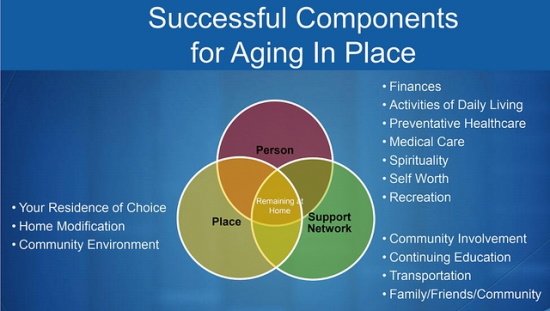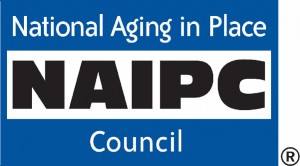Successful Aging In Place
How to Grow Older at Home
National Aging in Place Week is an
annual effort to expand awareness of the Aging in Place
movement and the availability of the means for seniors to
remain in their homes for as long as they would like.
To Age in Place simply
means that you will be remaining in your own home for the later
years of your life; not moving into a smaller home, assisted living,
retirement community, etc. It's a "lifestyle" choice, and
one that should not be taken lightly, as it's not right for
everyone.
Aging in Place Options
In-Home Care
Packed with people of all different physical
abilities, nursing homes can be overcrowded, limiting the amount of
attention and care that the staff can provide at any one time. But
with the assistance of agencies that provide
non medical in-home care, aging in place is now
made possible.
Most Americans do not make a plan to age in place, although you should start thinking about one before you plan to retire. Creating a plan can prevent unexpected events from turning into crises that compromise one's ability to live independently. "Successful" aging is important because it can help us understand what kinds of things we should focus on, to help more older adults age well, or otherwise "succeed" in late-life.
Smart Technology
For some seniors and the elderly
technology is
crucial in helping them Age in Place at home. Some believe
apps, sensors,
smart medical devices, and other technologies even have the
potential to make the nursing home obsolete. This may be overly
optimistic - but for some seniors and the elderly technology is
crucial in helping them age in place at home.
Is Aging In
Place Right For You?
In their
Retirement Report, Kiplinger addressed the
point, "Renovations are just a part of what you need to make aging
in place work for you. While it's typically less expensive to remain
in your home than to pay for assisted living, that doesn't mean it's
a slam dunk to stay put. You'll still have a long to-do list. Just
one example: You need to plan ahead for how you will manage
maintenance and care - for your home, and for yourself."
So before you spend the money to remodel or renovate your current house so you can age in place, reach out to a local real estate professional to determine if it is truly your best option. Making a move to a smaller home in the neighborhood might make the most sense.
Your home situation is unique, and several factors will weigh in on the best choice for you. Below are some successful components for Aging in Place:

 Finances.
Making a budget with anticipated
expenses can help you weigh the pros and cons of your situation.
Alternate arrangements like assisted living can be expensive,
but extensive in-home help can rapidly become expensive as well,
especially at higher levels of care and live-in or 24-hour
coverage.
Finances.
Making a budget with anticipated
expenses can help you weigh the pros and cons of your situation.
Alternate arrangements like assisted living can be expensive,
but extensive in-home help can rapidly become expensive as well,
especially at higher levels of care and live-in or 24-hour
coverage.
 Social
Engagement/Recreation.
The effects of social
isolation among the elderly are frightening: increased risk of
long-term illness, cognitive decline, depression, pessimism,
sedentary lifestyle, poor diet, and early mortality, to name a
few. But if seniors don't make an active effort to expand their
social circle and form new bonds, their social connection
inevitably wanes as friends, relatives, and spouses pass away.
Social
Engagement/Recreation.
The effects of social
isolation among the elderly are frightening: increased risk of
long-term illness, cognitive decline, depression, pessimism,
sedentary lifestyle, poor diet, and early mortality, to name a
few. But if seniors don't make an active effort to expand their
social circle and form new bonds, their social connection
inevitably wanes as friends, relatives, and spouses pass away.
Staying socially engaged is central to successful aging. A network of meaningful relationships not only brings purpose to a senior's days, it also ensures that older adults have a support system when they fall upon difficult times. An elderly person who has friends, family and neighbors who can check in, provide short-term caregiving, or help run errands has an increased ability to age in place even when faced with health issues.
 Activities of Daily Living.
Deficits in basic self-care activities have been linked to older
adults' ability to remain in their home. Activities of daily
living refer to the basic skills needed to properly care for
oneself and meet one's physical needs in six areas: eating,
dressing, bathing, toileting, continence and mobility.
Understand how to assess your aging loved one's ability to
complete activities of daily living (ADLs) to help ensure they
live their best life.
Activities of Daily Living.
Deficits in basic self-care activities have been linked to older
adults' ability to remain in their home. Activities of daily
living refer to the basic skills needed to properly care for
oneself and meet one's physical needs in six areas: eating,
dressing, bathing, toileting, continence and mobility.
Understand how to assess your aging loved one's ability to
complete activities of daily living (ADLs) to help ensure they
live their best life.
 Preventative Healthcare.
Preventative Healthcare.
Preventive services are important for everyone, especially for
older adults. This is because your risk for health problems
increases as you age.
 House
Maintenace and Upkeep.
One's home environment requires predictable maintenance such as
changing furnace filters, cleaning floors, replacing light
bulbs, and mowing the lawn. But unpredictable events might arise
that can demand increased effort on the resident's part. For
example, a strong thunderstorm may rip shingles off the roof
resulting in water damage to the inside ceiling of the home. The
resident must take quick action to repair the damage. The extent
to which residents are able to manage such environmental demand
fluctuations determines the quality of interaction between the
person and the environment.
House
Maintenace and Upkeep.
One's home environment requires predictable maintenance such as
changing furnace filters, cleaning floors, replacing light
bulbs, and mowing the lawn. But unpredictable events might arise
that can demand increased effort on the resident's part. For
example, a strong thunderstorm may rip shingles off the roof
resulting in water damage to the inside ceiling of the home. The
resident must take quick action to repair the damage. The extent
to which residents are able to manage such environmental demand
fluctuations determines the quality of interaction between the
person and the environment.
 Household chores. Do
you need help with chores like housecleaning, yard work, grocery
shopping, or laundry? Some grocery stores and drug stores will
take your order over the phone and bring the items to your home.
There are cleaning and yard services you can hire, or maybe
someone you know has a housekeeper or gardener to suggest. Some
housekeepers will help with laundry. Some drycleaners will pick
up and deliver your clothes.
Household chores. Do
you need help with chores like housecleaning, yard work, grocery
shopping, or laundry? Some grocery stores and drug stores will
take your order over the phone and bring the items to your home.
There are cleaning and yard services you can hire, or maybe
someone you know has a housekeeper or gardener to suggest. Some
housekeepers will help with laundry. Some drycleaners will pick
up and deliver your clothes.
 Isolation.
Another risk of aging in place is related to social isolation.
It is well documented that elders often become more isolated as
they age. The concern here is that there is a growing body of
evidence that Elders who are socially isolated are at greater
risk of early death.
Isolation.
Another risk of aging in place is related to social isolation.
It is well documented that elders often become more isolated as
they age. The concern here is that there is a growing body of
evidence that Elders who are socially isolated are at greater
risk of early death.
 Medical conditions. No one can predict the
future. However, if you or a loved one has a chronic medical
condition that is expected to worsen over time, it's especially
important to think about how you will handle health and mobility
problems. What are common complications of your condition, and
how will you handle them?
Medical conditions. No one can predict the
future. However, if you or a loved one has a chronic medical
condition that is expected to worsen over time, it's especially
important to think about how you will handle health and mobility
problems. What are common complications of your condition, and
how will you handle them?
National Aging in Place Council
The National Aging in Place Council is a respected national
leader and trusted partner to help people aged 60+ meet the
challenges of aging. We partner with nonprofit organizations,
government, and business to provide innovative community
programs and services, online help, and advocacy.
Template for Successful Aging in Place
Aging in Place Specialists
Aging
in place specialists are people who consult with construction
companies and homeowners in remodeling homes for the needs of
older adults. Some contractor's work with people certified
in aging in place design and remodeling.
AARP, the National Association of Home Builders and Home Innovation Research Labs offer a Certified Aging in Place Specialist credential for experts in the field. If you are considering making adjustments to your home, ask your construction company if they work with a certified aging-in-place specialist.

-
Nearly 90 percent of seniors want to stay in their own homes as they age, often referred to as "aging in place."
-
Even if they begin to need day-to-day assistance or ongoing health care during retirement, most (82 percent) would prefer to stay in their homes. Only a few express a preference for moving to a facility where care is provided (9 percent) or for moving to a relative's home (4 percent).
-
Living under one's own rules is a key reason for staying in one's own home, with 42 percent of seniors choosing it as one of their top three considerations.
Related Articles:
- Texas Area Agency on Aging
- Aging in Place Home Automation Technology
- Home Modifications for Aging in Place
- The Future of Our Aging Population
- Talking to Your Parents About Aging Issues
- The Growth of Texas Aging Population
Home | About | Articles | Resources | Site Map | Privacy Policy
Elder Options of Texas
Copyright 2001-2024
All Rights Reserved
DISCLAIMER: Links to other websites or references to products, services or publications do not imply the endorsement or approval of such websites, products, services or publications by Elder Options of Texas. The determination of the need for senior care services and the choice of a facility is an extremely important decision. Please make your own independent investigation.



